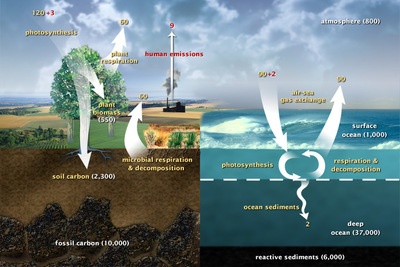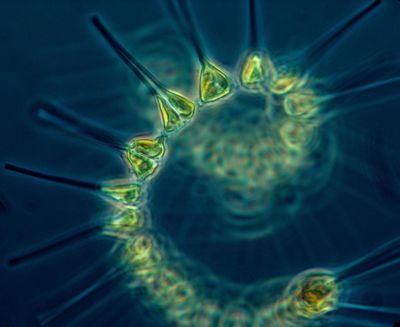The Carbon Cycle
Carbon Subcycles

Carbon Cycles
Yellow = natural fluxes
Red = human contributions
White = stored carbon
Source: NASA Earth Observatory
The carbon cycle actually consists of several different earth system interactions. Each of these interactions involve transitions of carbon atoms from one earth system to another. Some carbon transitions are relatively fast, such as those involving living organisms; some are slower, such as those involving the ocean and atmosphere; some are very slow, involving transitions into and out of sediment and rock formations.
There are three principal subcycles of the overall carbon cycle. Although we list them separately for purposes of simplification, all three of these subcycles are intrinsically entwined, with complex interactions that constitute a single, albeit complex, carbon cycle:
The above listed parts of the carbon cycle are shown in the image shown above.
Terrestrial Organic Carbon Cycle
The terrestrial organic carbon cycle consists of those transitions and reactions that a carbon atom undergoes in the environment of land and atmosphere. These consist of time spent in the atmosphere, absorption into plants in the course of photosynthesis, consumption by animals, decay in the earth by bacteria and eventual passage by water to the ocean, where it enters the marine organic carbon cycle or settles to the ocean bottom and becomes sediment.
Some of these terrestrial transitions are relatively fast, particularly those that involve incorporation into plants, consumption by animals, and later decay of organic waste. An exception is carbon which finds its way into the trunks and roots of long-living trees, which actually comprises most of terrestrial organic carbon.
The slow cycles involve the formation of carbon-containing sediments and eventual hardening into layers of rocks at the bottom of the oceans. Carbon atoms may remain in these sediments for millions of years, until they are once again lifted to the surface of continents by tectonic shifts and volcanic activity.
Marine Organic Carbon Cycle

Phytoplankton
Source: NOAA MESA Project
The marine organic carbon cycle is similar in many ways to the terrestrial organic carbon cycle. Both are driven by the photosynthetic generation of oxygen and carbohydrates from carbon dioxide and water, using energy provided by the sun. In the oceans the principal organisms that provide photosynthesis are microscopic and free-floating in the top layers of the oceans, where sunlight is available. The most common of these organisms are phytoplankton, one variation of which is shown in the image above.
Inorganic Carbon Cycle
Inorganic carbon compounds are compounds that are not part of the constitution of living organisms. The inorganic carbon cycle is an array of carbon pathways that involve such phenomena as diffusion of carbon dioxide from the atmosphere into the ocean and vice versa, the deposition of carbonates into sediments at the ocean bottom, and chemical weathering of limestone and other carbon-containing minerals by rain in terrestrial environments.